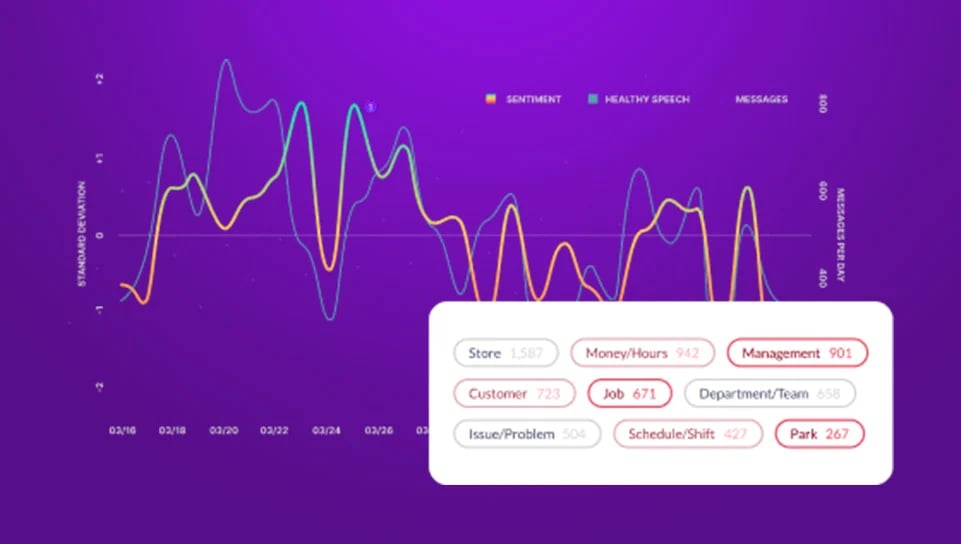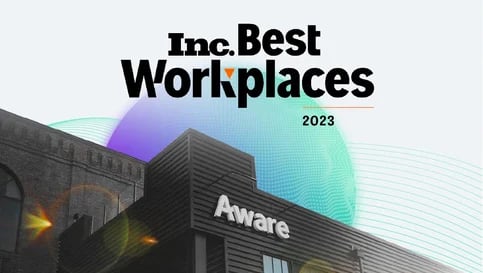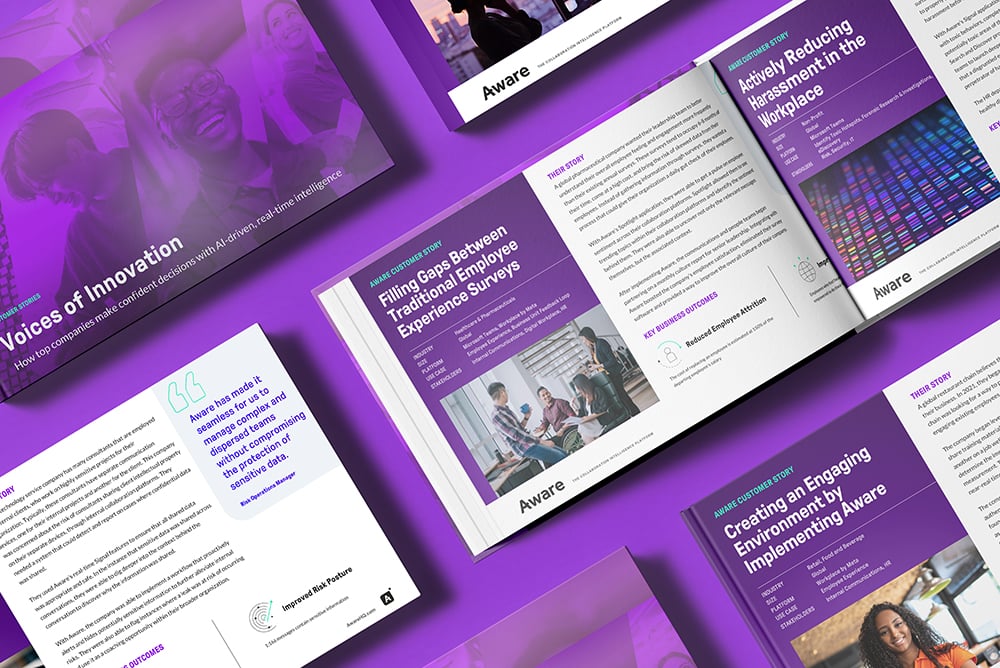AWARE FOR COMPLIANCE ADHERENCE
Compliance made easy
Seamlessly enforce internal, industry, and regulatory requirements in real-time.
1:166 messages sent on platforms like Slack, Teams and Zoom contain sensitive data. With Aware, you can easily surface and mitigate instances of non-compliance, protecting both your organization and your employees.
Reduce regulatory exposure
Reduce the likelihood of costly fines with rules-based policy enforcement.
Improve risk posture
Support for multiple collaboration tools surfaces blind spots across digital conversations, in one platform.
Protect company culture
Immediate notification of acceptable use violations, including undesirable behavior.
What can you do with Aware?
Proactively detect non-compliance
Ingest data across platforms in real time, surfacing communication containing sensitive data that could put your organization at risk of violating HIPAA, HITRUST, FINRA, PCI, GDPR and more.
Streamline compliance coaching
Real-time automated coaching alerts employees of appropriate communication in collaboration datasets.
Automatically enforce acceptable use policies
Leverage proprietary ML/AI to surface inappropriate or unwanted behavior in communications, including context for full understanding.
Identify, address and enforce compliance across your ecosystem
Aware automatically enriches data from tools like Slack, Zoom, and Microsoft Teams to detect regulatory risks, enable efficient compliance workflows, and secure your collaboration ecosystem.
Data Management
Create custom policies designed to detect specific topics or activities across your collaboration ecosystem, allowing you to stay secure and compliant.
- Purpose-built machine learning models surface violations across various files types with industry-leading accuracy.
- Fully configurable workflows automatically enforce policies.
- Policy reporting & analytics uncover key areas of risk.
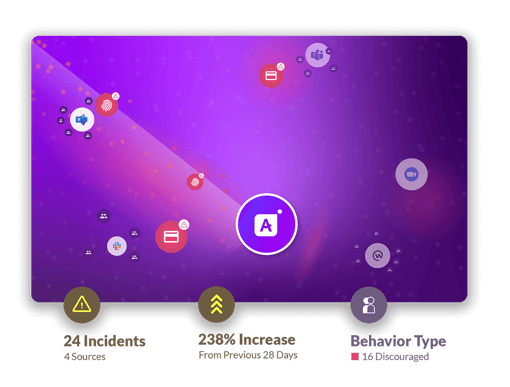
RESOURCES
Learn more about protecting your business from the risks of collaboration.
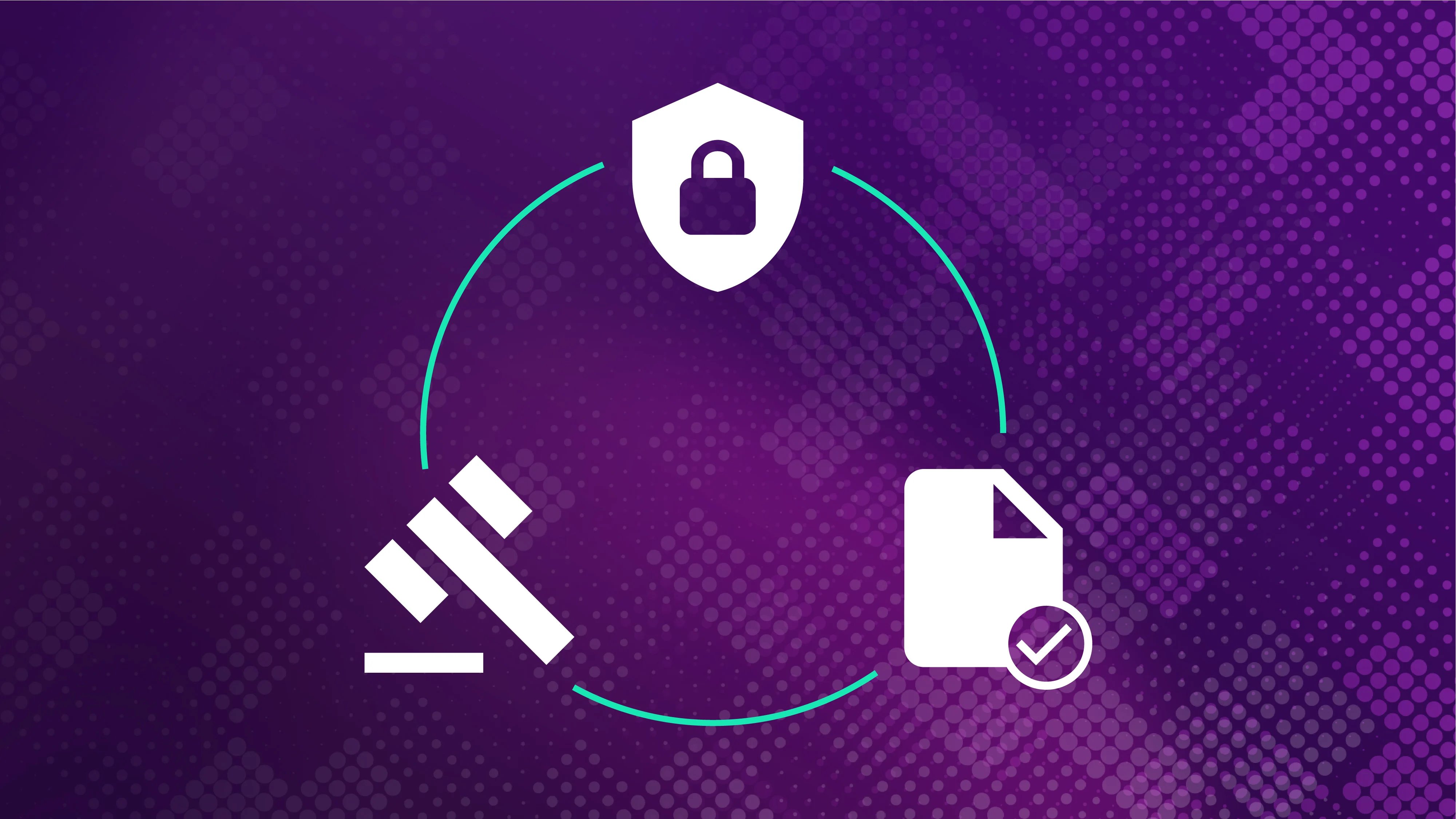
Whitepaper
An IT Leader’s Guide to Compliance, Legal, and InfoSec Requirements in Collaboration
Everything You Need to Know to Support Your Colleagues and Improve Your Risk Posture
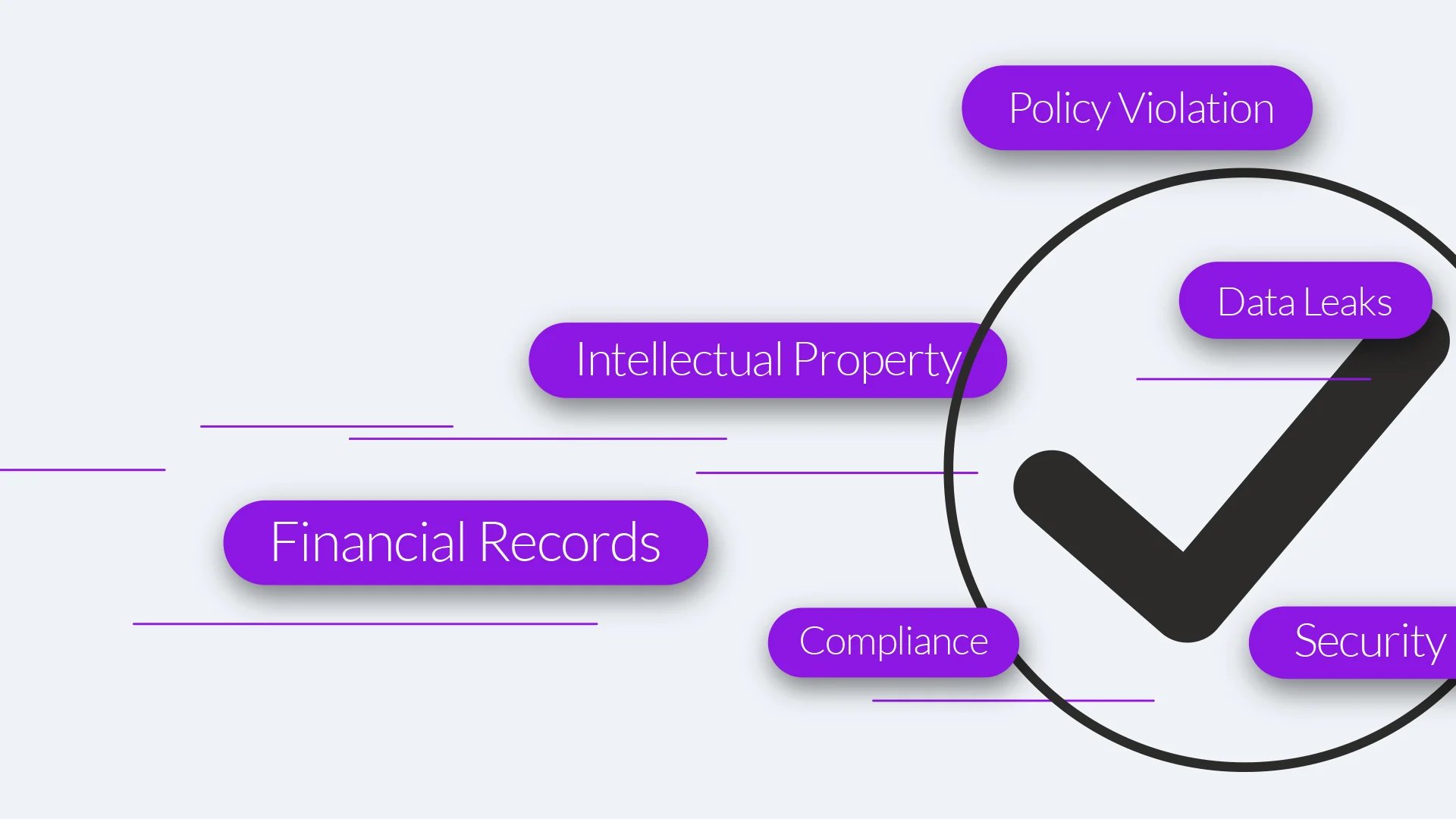
Checklist
A Quick Checklist for Collaboration Security
This checklist helps IT leaders identify the stakeholders that influence collaboration data security and develop a governance and enrichment strategy that reduces risk and keeps collaboration secure and compliant.
Frequently asked questions
What are collaboration tools?
The modern workplace requires new ways of working. Collaboration tools enable remote and distributed teams to work both asynchronously and in real time. Some of the leading collaboration tools today include Slack, Microsoft Teams, Webex by Cisco, Zoom Team Chat, Google Drive, and Workplace from Meta. Using these tools, coworkers can send instant messages, use video and audio chat, share files and images, and respond to posts through gifs, emojis, and buttons. It is a new dataset, filled with nonlinear, unstructured information and nonstandard characters and content.
What is compliance adherence?
Sensitive information such as credit card details, names and address, and confidential company data proliferate across collaboration datasets. This leaves organizations at risk. Compliance adherence is how businesses ensure their internal policies meet legal and regulatory requirements regarding how they handle this sensitive data. Additionally, compliance adherence reviews how employees handle and share data to confirm they follow policy at all times. Successful compliance adherence ensures the enterprise is operating in a responsible and ethical manner and proactively identifies and mitigates risk associated with noncompliance.
What sort of noncompliant data exists in collaboration datasets?
When a business permits employees to conduct work through collaboration tools, they must anticipate that tool being used to share all company-related data. This includes sensitive, confidential, and protected information such as business strategies, financial reports, HR information, and payroll details. Some types of regulated information commonly found within collaboration messages includes:
- Personally identifying information (PII) — government-issued ID numbers, addresses, phone numbers
- Protected health information (PHI) — medical absence details, upcoming appointments, documented diagnoses and disabilities
- Payment card industry (PCI) data — bank account numbers, payment card details, billing addresses
Aware can help organizations to mitigate risk within collaboration datasets by automating compliance adherence.
How can organizations enforce internal compliance within collaboration tools?
As well as supporting the detection of protected information within collaboration tools using regular expressions, Aware enables organizations to enforce internal compliance. Workspace administrators can create their own compliance adherence workflows to automatically detect the unauthorized sharing of confidential company information. This can include details such as mergers and acquisitions, sales playbooks, financial records and more. Aware can also support the detection of code-sharing in unauthorized channels, and restricted file uploads.
What regulatory compliance issues affect collaboration datasets?
Collaboration tools are relatively new in the business world, and regulators are still catching up to the existence of this new dataset and the compliance risks it contains. However, recent lawsuits have made it clear that more and more regulators, including FINRA and the FCC, expect businesses to manage and monitor compliance within collaboration data. This poses a problem for many businesses because collaboration tools weren’t built with compliance in mind. That means identifying noncompliant information and mitigating risk in this sprawling, tangled dataset can be extremely difficult, time consuming, and expensive.
Are collaboration tools HIPAA, FINRA, and GDPR compliant?
- HIPAA (Health Insurance Portability and Accountability Act) — protects the privacy and security of individuals' personal health information.
- FINRA (Financial Industry Regulatory Authority) — regulates and oversees the securities industry in the United States.
- GDPR (General Data Protection Regulation) — protects the personal data and privacy of EU citizens.
Collaboration tools are not compliant with major regulations like HIPAA, FINRA, or GDPR right out the box. However, they can be used in a compliant manner by implementing the right controls and coaching employees on appropriate use practices. Some ways to make collaboration tools compliant with regulations like GDPR, HIPAA, and FINRA include setting retention policies that meet regulatory need, coaching employees on what information they can and cannot share in collaboration, and implementing an automated compliance adherence platform like Aware that can detect noncompliance and establish retention rules within collaboration messages.
How does Aware help organizations to mitigate noncompliance?
Aware addresses compliance needs within collaboration tools in several ways:
- Automated compliance adherence detects when non-compliant information is shared within collaboration messages in real time. Organizations can establish rules for legislation such as FINRA and HIPAA or create their own rules to meet specific industry requirements or internal compliance policies.
- Granular retention policies establish what data should be kept and what purged from within collaboration environments and supports the automated removal of that data from the centralized archive.
- Train employees and provide real-time compliance coaching whenever noncompliant content is detected within collaboration. Automated workflows can flag content and deliver immediate feedback to employees to improve risk posture and strengthen compliance.
What other steps should businesses take to mitigate risk and improve risk posture in collaboration?
Creating a fully compliant workspace within collaboration tools requires a considered and deliberate approach. Collaboration tools are not automatically or intuitively compliant with any major legislation but do enable the functionality to be used in a compliant manner. Sometimes this requires upgrading your tool subscription to a higher tier workspace or implementing a third-party compliance solution like Aware (or both!).
Even in fully compliant collaboration environments, other risks still exist. Employees may share restricted or sensitive information, engage in harassment or toxic speech, or even conduct unlawful activities such as insider trading or illegal gambling. Aware enables businesses to take charge of unauthorized activities within collaboration tools by automatically ingesting and analyzing messages to flag misuse and toxicity in real time.
Does Aware support automated compliance training within collaboration?
Yes. Aware ingests collaboration messages and analyzes them for noncompliance in real-time. This enables real-time compliance training by immediately flagging the noncompliant message and automatically coaching the employee on the correct use of collaboration tools.
What other use cases does Aware support in addition to compliance adherence?
Aware was built for collaboration. The Aware platform ingests messages in real time from all major collaboration tools, including Slack, Microsoft Teams, Webex by Cisco, Zoom Team Chat, Google Drive, Workplace from Meta and more. It infuses those messages with AI/ML insights normalized for the nuances of collaboration to deliver complete, contextual understanding of what is happening with the entire collaboration environment. As a result, Aware solves a wide range of use cases, including: data loss prevention (DLP), insider risk detection, forensics and investigations, eDiscovery, employee experience, toxic hot spot detection, information governance, business feedback loops and key initiative tracking.





